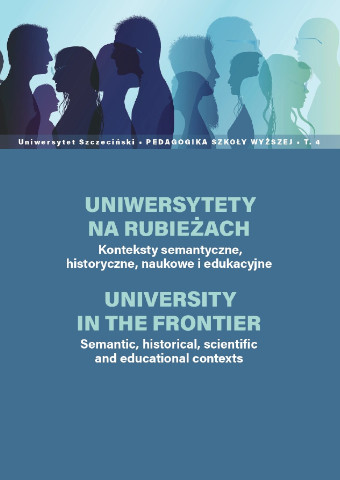
ISBN: 978-83-7972-559-5
ISBN (online): 978-83-7972-560-1
ISSN: 2083-4381
OAI


Lista wydań /
T. 4
The frontier university graduates in the labour market.
| Autorzy: |
Anna
Murawska

University of Szczecin Piotr Walkowiak 
University of Szczecin |
| Słowa kluczowe: | university frontiers employability |
| Data publikacji całości: | 2022 |
| Liczba stron: | 14 (435-448) |
Abstrakt
Recent decades have been a time of unusually intense changes taking place in all areas of life, including the higher education institutions. One direction of change is economic instrumentalism. According to it, universities and other higher education institutions are perceived and treated as institutions of the market. Their performance is evaluated on the basis of ‘measurable’ indicators that will justify the expenditure of public money. One such indicator is employability.
The purpose of the chapter is to study the situation of the frontier university graduates in the labour market and to search for answers to the following questions: what types of activities do graduates of these universities engage in? What kind of remuneration do they receive for their work? Does the frontier location make the situation of graduates different from those who graduate from universities located in the centre?
The analyses were based on the existing data. Two data sources were used. The first one is the National System for Monitoring the Economic Fate of University Graduates (Pol.: ELA). The second source is data collected by the Academic Career Service of the University of Szczecin and made available to the authors of the text. Taking into account the geographical understanding of the frontier, the following universities were considered in the analysis: the University of Warmia and Mazury, The University of Białystok, the University of Rzeszów, the University of Opole, the University of Szczecin and the University of Zielona Góra. Thus, in order to compare the situation of the frontier university graduates, the data pertaining to graduates of the universities representing the centre – the Warsaw University, the Jagiellonian University and the Adam Mickiewicz University in Poznań – were also included.
Pobierz plik
Plik artykułu
Bibliografia
| 1. | Bański, J. (2010). Granica w badaniach geograficznych – definicja i próby klasyfikacji. Przegląd Geograficzny, 4 (82), 489–508. |
| 2. | Bezrobotni zarejestrowani i stopa bezrobocia. Stan w końcu grudnia 2020 r. Pobrane z: https://stat.gov.pl/obszary-tematyczne/rynek-pracy/bezrobocie-rejestrowane/bezrobotni-zarejestrowani-i-stopa-bezrobocia-stan-w-koncu-grudnia-2020-r-,2,101.html (10.07.2022). |
| 3. | Bologna beyond 2010. Report on the development of the European Higher Education Area (2009). Pobrane z: http://www.ehea.info/media.ehea.info/file/2009_Leuven_Louvain-la-Neuve/91/8/Beyond_2010_report_FINAL_594918.pdf (10.07.2022). |
| 4. | Byrne, Ch. (2020). What determines perceived graduate employability? Exploring the effects of personal characteristics, academic achievements and graduate skills in a survey experiment. Studies in Higher Education, 47 (1). DOI: 10.1080/03075079.2020.1735329. |
| 5. | Cheng, M., Adekola, O., Albia, J., Cai, S. (2022). Employability in higher education: a review of key stakeholders’ perspectives. Higher Education Evaluation and Development,16 (1). DOI: 10.1108/HEED-03-2021-0025. |
| 6. | Clarke, M., (2017). Rethinking graduate employability: the role of capital, individual attributes and context. Studies in Higher Education, 11 (43) 1923–1937. DOI:10.1080/03075079.2017.1294152. |
| 7. | Crosier, D., Purser, L., Smidt, H. (2007). Trends V. Universities Shaping the European Higher Education Area. An EUA Report. |
| 8. | Dolot, A. (2018). Proces poszukiwania pracy przez młode pokolenie – wybrane zagadnienia – wyniki badań empirycznych. Studia Ekonomiczne. Zeszyty Naukowe Uniwersytetu Ekonomicznego w Katowicach, 359, 284–299. |
| 9. | Gromkowska-Melosik, A. (2015). Dostęp kobiet i mężczyzn do studiów wyższych. Studium porównawcze. Rocznik Lubuski, 41, 39–49. |
| 10. | https://ec.europa.eu/eurostat/statistics-explained/index.php?title=Employment_rates_of_recent_graduates&oldid=568227#Employment_rates_of_recent_graduates_over_time (10.07.2022). |
| 11. | https://eua.eu/downloads/publications/trends%20v%20universities%20shaping%20the%20european%20higher%20education%20area.pdf (10.07.2022). |
| 12. | Macheridis, N., Paulsson, A. (2021). Tracing accountability in higher education. Research in Education, 110 (1), 78–97. |
| 13. | Macionis, J. J. (2012). Sociology. New Jersey: Pearson. |
| 14. | Mokrzycka, K. (2019). Absolwent potrzebny od zaraz. Obserwator finansowy.pl. Pobrane z: https://www.obserwatorfinansowy.pl/forma/analizy-debata/analizy/absolwent-potrzebny-od-zaraz/ (12.07.2022). |
| 15. | Nymś-Górna, A., Sobczak, A. (2018). Akademickie biura karier i ich rola w poradnictwie zawodowym dla studentów, Zeszyty Naukowe Państwowej Wyższej Szkoły Zawodowej im. Witelona w Legnicy, 26 (1), 111–121 |
| 16. | Paculska, M. (2014). Zatrudnialność jako kryterium oceny uczelni. W: M. Pawlak, Ł. Srokowski (red.), Pomiędzy i wewnątrz. Instytucje, organizacje i ich działania (s. 205–229). Warszawa: Instytut Profilaktyki Społecznej i Resocjalizacji, Uniwersytet Warszawski. |
| 17. | Pokorska, A. (2020). Co liczyć i na kogo liczyć? Produktowa i nieproduktowa aktywność naukowa w kontekście uczelni badawczej – perspektywa kluczowych grantobiorców. Przegląd Socjologiczny, 69 (4), 65–90. DOI: 10.26485/PS/2020/69.4/3. |
| 18. | Potulski, J. (2010). Geopolityka w świecie ponowoczesnym. Częstochowa: Instytut Geopolityki. |
| 19. | Stachura, E. (1969). Cała jaskrawość. Warszawa: Wydawnictwo Czytelnik. |
| 20. | Stoten, D. (2018). Employability: a contested concept in higher education. Journal of Pedagogic Development, 8 (1), 9–17. |
| 21. | Ustawa z 20.04.2004 r. O promocji zatrudnienia i instytucjach rynku pracy (Dz.U. z 2021, poz. 1100, 1162, 1621, 2270, 2317, 2445; z 2022, poz. 91). |
| 22. | Wiśniewska, S. (2015). Zatrudnialność – pojęcie, wymiary, determinanty. Edukacja Ekonomistów i Menedżerów, 35 (1), 11–24. |